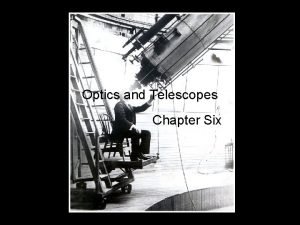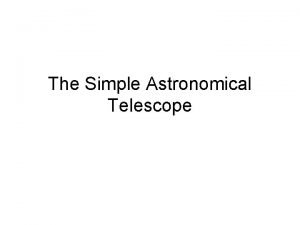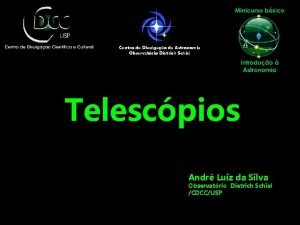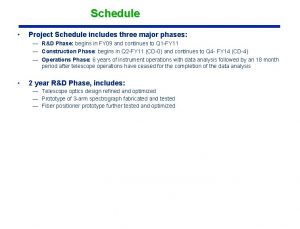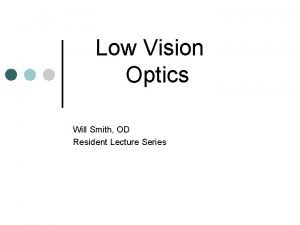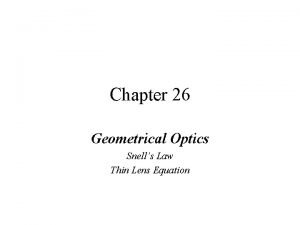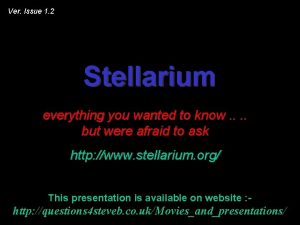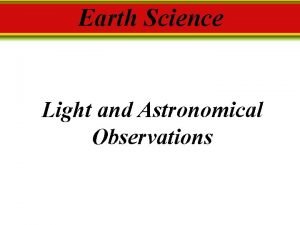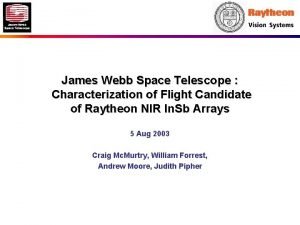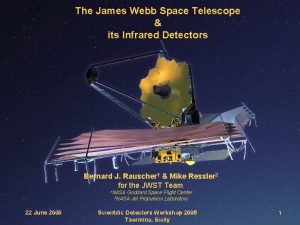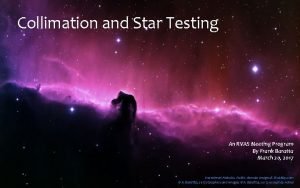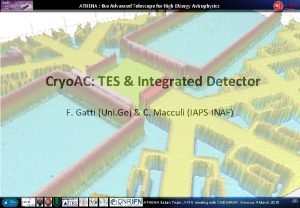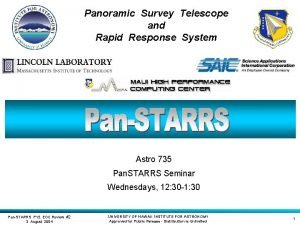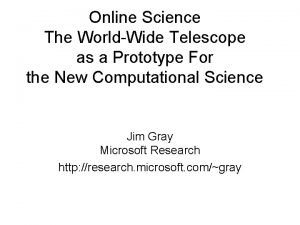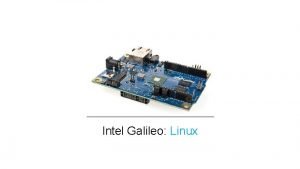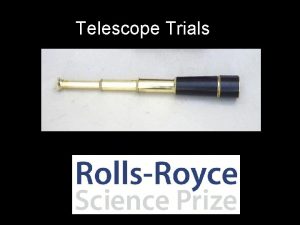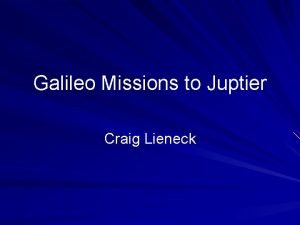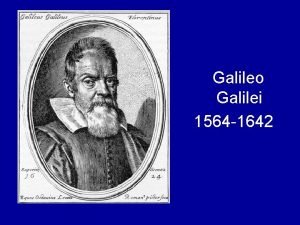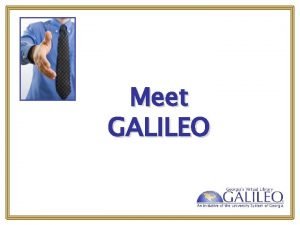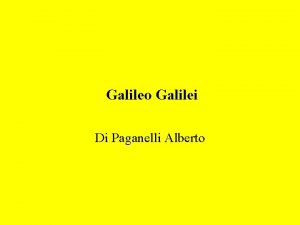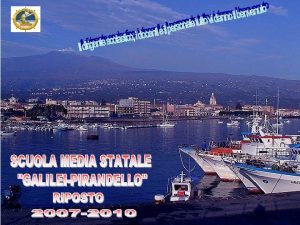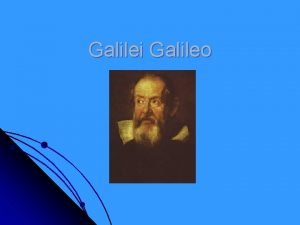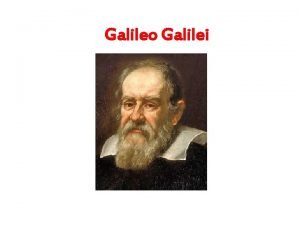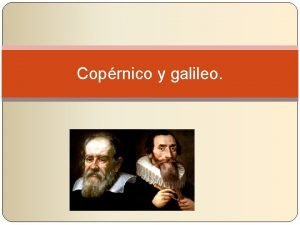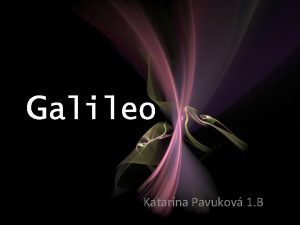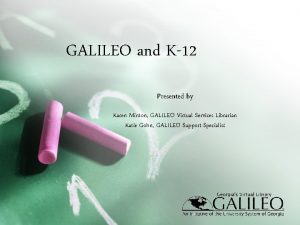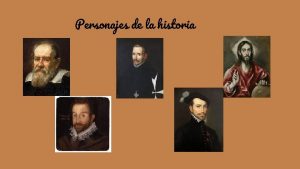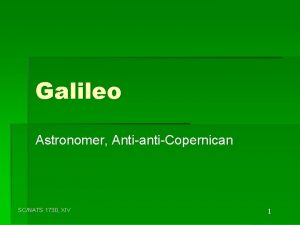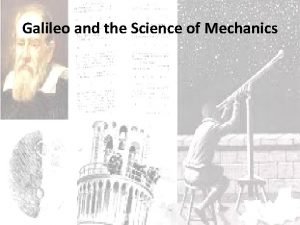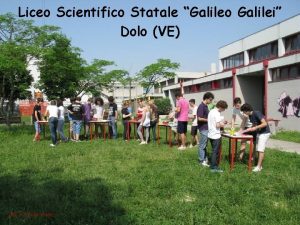Rise of the Telescope Galileo Rise of the




















- Slides: 20

Rise of the Telescope: Galileo

Rise of the Telescope: Galileo January 19, 1610 stellar occultation Photographs taken using a telescope similar to Galileo’s by Tom Pope (www. pacifier. com/~tpope) compared to engraving from Sidereus Nuncius. Upper photo corresponds to a Keplerian telescope; lower is what Galileo would have seen.

Rise of the Telescope: Galileo Copernicus, Heraclides or Tycho Galileo’s drawing of the phases of Venus and modern photo-mosaic Ptolemy

Rise of the Telescope: Galileo The discovery page from Galileo’s notebook A later systematic study One of Tom Pope’s photographs

Rise of the Telescope: 17 th cen. Hevelius, 1643 Hevelius, 1647 Riccioli, 1651 Huygens, 1659

Rise of the Telescope: 17 th cen. Scheiner’s helioscope, 1638: first equatorial mount Roemer’s transit circle, 1684

Rise of the Telescope: 17 th cen. Hevelius’ 60 -foot telescope, 1673 Huygens’ aerial telescope, 1684

Rise of the Telescope: Newton’s reflector, 1671 Newton’s drawing of his prism experiment. This demonstrates the cause of chromatic aberration (and the basis of spectroscopy) Second prism shows no further change

Rise of the Telescope: Hadley Gregorian reflector with 6 -in mirror, 1721. Also invented sextant, 1730.

Rise of the Telescope: Herschel

Rise of the Telescope: Lord Rosse

Rise of the Telescope: Dollond Image of slit through 20 cm single lens and doublet, http: //www. physics. umd. edu/lecdem/

Rise of the Telescope: Parallax Dorpat refractor Konigsberger heliometer Fraunhofer Struve Henderson Bessel

Rise of the Telescope: the AU Solar parallax (arcsec) Solar parallax 10 9. 8 9. 6 9. 4 9. 2 9 8. 8 8. 6 8. 4 8. 2 8 1600 8. 81 Solar parallax (arcsec) 8. 808 1769 Venus transit 1700 1800 Date 1900 2000 Solar parallax 8. 806 8. 804 First radar measurement 8. 802 8. 8 8. 796 8. 794 8. 792 8. 79 1900 1920 1940 1960 Date 1980 2000

Photography Lewis Morris Rutherfurd Chromatic aberration in an achromatic refractor set up for visual use

Photography Henry Draper’s 1882 photo of the Orion Nebula A modern HST image

Photography John Herschel, 1830 s Henry Draper, 1882 David Malin, 1979 Lord Rosse, 1840 s Small images from http: //www. rit. edu/~photo/IFS/About-IFS. html

Photography Early photographs from Pedro Re’s collection of scanned plates: above M 31 and M 33 by Isaac Roberts; above right Comet Swift in 1892 by EE Barnard; right the Pleiades by JE Keeler

Spectroscopy Fraunhofer’s 1823 spectrum compared with a modern spectrum of similar dispersion. Early photographic spectrum by William Huggins showing nebular lines

Spectroscopy Harvard College Observatory spectroscopy for the Henry Draper catalogue
 Tricky dicky richard nixon
Tricky dicky richard nixon Rise and rise again until lambs become lions
Rise and rise again until lambs become lions Rise and rise again until lambs become lions origin
Rise and rise again until lambs become lions origin Sheep become lions
Sheep become lions Telescope how to use
Telescope how to use Angular magnification of astronomical telescope
Angular magnification of astronomical telescope Magnitude limite telescope
Magnitude limite telescope Telescope how begins
Telescope how begins Will smith od
Will smith od Galilean telescope magnification
Galilean telescope magnification Stellarium scope
Stellarium scope Pointing model telescope
Pointing model telescope Which telescope detects invisible electromagnetic radiation
Which telescope detects invisible electromagnetic radiation Raytheon james webb space telescope
Raytheon james webb space telescope James webb space telescope nasa
James webb space telescope nasa Star testing astronomical telescopes
Star testing astronomical telescopes Advanced telescope for high energy astrophysics
Advanced telescope for high energy astrophysics University of hawaii
University of hawaii Worldwide telescope online
Worldwide telescope online Telescope series
Telescope series A refracting telescope produces an image using a(n) ____.
A refracting telescope produces an image using a(n) ____.




